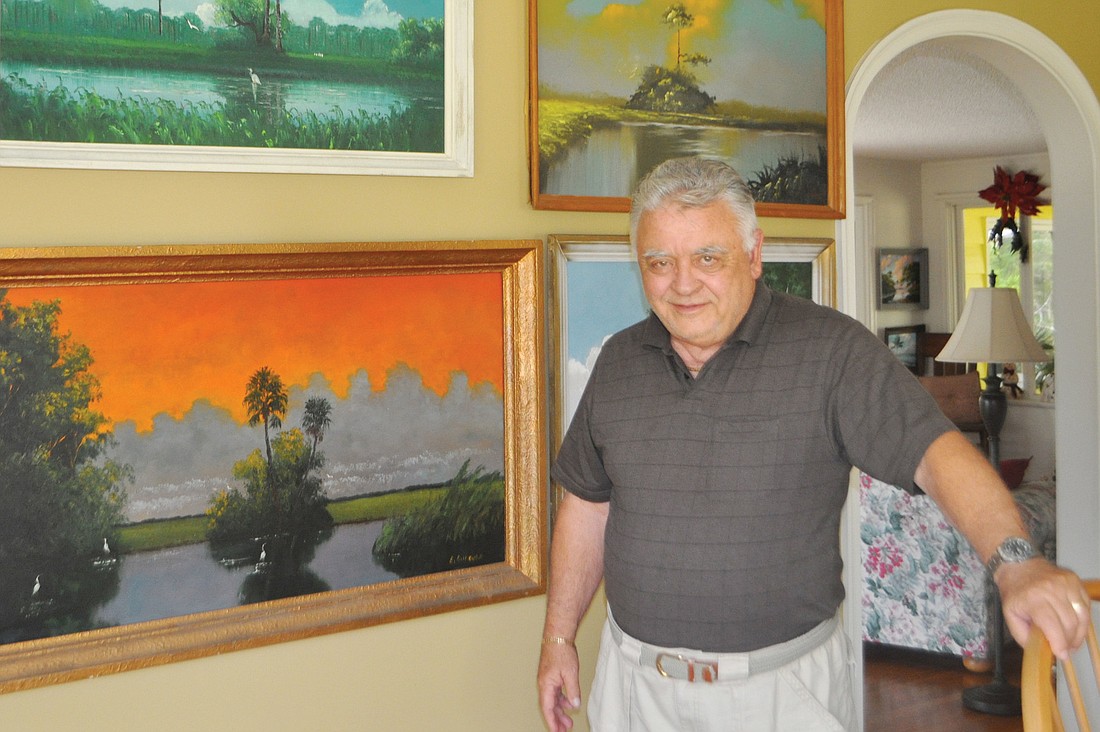- April 16, 2024
-
-
Loading

Loading

The paintings were hung in dentist offices, motels, funeral homes and restaurants.
If you drove the highways of Florida’s east coast in the 1960s and 1970s, particularly U.S. Highway 1, there’s a good chance you saw the picturesque landscape scenes of the state.
They depicted swamps, waves, pink skies and palm trees with vibrant oil paint colors on Upson boards. Many show scenes of a Florida that has disappeared with development.
Their creators, who would later become known as Florida’s Highwaymen, were both artists and salesmen.
From the mid-1950s to the early 1980s, they painted quickly and furiously, often finishing paintings in less than an hour.
They traveled the highway, going business-to-business, door-to-door, selling their paintings out of their cars for around $25 a pop. For the 26 artists, all African-American, most of whom lived around Fort Pierce, art was a way to build a better life in the Jim Crow South, where job opportunities for blacks were usually limited to factory and farm work.
No one knows how many paintings the Highwaymen produced, but most estimates put the total at more than 200,000.
A renewed interest in the Highwaymen generated demand for the paintings in the 1990s. Collectors scoured antique stores, garage sales and thrift shops in search of the paintings.
Today, those paintings often cost more than $2,000.
Michelle Obama, Jeb Bush, Shaquille O’Neal and Steven Spielberg are all said to be collectors.
For many collectors, it isn’t just the art itself, but also the story behind it.
Siesta Key resident Lawrence “Larry” Helmuth, a former Sarasota County School Board chairman, first watched a documentary about the Highwaymen in 2001, on PBS.
The next day, he hit the road, en route to Florida’s east coast in search of Highwaymen art.
Today, Helmuth’s collection totals 50 paintings, all of which will be on display in an exhibit that will run Jan. 18 through March 1, in the Durante Gallery at the Longboat Key Center for the Arts, a Division of Ringling College of Art and Design.
Helmuth was drawn to the artwork for multiple reasons.
He admired the entrepreneurial spirit of its creators and the rapidly vanishing scenes of Florida that it depicted.
He was also fascinated by the art’s historical significance.
“Most Americans can’t name one black artist,” he said. “They can name black musicians, they can name black athletes, but they cannot name one black artist.”
…
A.E. “Beanie” Backus was a white painter known as the dean of Florida landscapes.
He grew up in Fort Pierce, the site of Ku Klux Klan marches during his childhood, yet still kept his doors open to anyone of color, according to the 2012 NPR special, “The Highwaymen: Speed Painting in the Sunshine State.”
Backus met a talented black teenager named Alfred Hair in the 1950s, when Hair’s art teacher, Zanobia Jefferson, asked him to teach the youth. Backus hired Hair to build canvasses and also gave him lessons.
Soon, Hair discovered that if he could paint fast, he could make money. Hair taught many of the artists today known as the Highwaymen to speed paint and make a living selling their artwork.
Backus also mentored Harold Newton, a self-taught painter who switched from religious scene to landscapes.
Newton would become known for his attention to detail, rather than speed, and is today regarded as one of the most talented of the Highwaymen.
R.L. Lewis is one of 18 surviving Highwaymen artists and owns a gallery in Cocoa today.
He was the only one of the 26 painters born in Brevard County; he started painting in 1958 after he was injured playing football. His first drawing featured the Indian River Lagoon.
His art teacher, Alberta Leisure, “was constantly in my ear for the rest of my high school,” from then on, according to Lewis.
Lewis said that he never fathomed he could make a living as an artist, but credits meeting Newton with having a “push-pull effect” that caused him to pursue art.
He said there was a “method to the madness” of selling the paintings. He is currently compiling his memoirs and has included a chapter called “The Art of the Sale.”
“It was about establishing a rapport,” he said. “You figured out how to walk into places with no solicitation signs and make sure people knew you.”
Lewis graduated from college and taught junior high school for more than 30 years and also taught anonymously at Brevard Community College.
But, for many artists, the paintings themselves were a path out of poverty.
Artist Mary Ann Carroll (the only Highwaymen woman) raised seven children whom she primarily supported through selling paintings.
As for Hair, his goal was to become a millionaire by age 30, and many say he was probably almost there when he died at age 29. He was killed in 1970 in a shootout at a juke joint after fighting over a woman.
The Highwaymen got their moniker in 1995, when Jim Fitch wrote an article titled “The Highwaymen” for Antiques & Art Around Florida.
In the 1990s, interest in the Highwaymen grew as the artists were featured in numerous articles and documentaries.
Of the 18 surviving artists, the majority continues to paint today.
The 26 artists were inducted into the Florida Artists Hall of Fame in 2004, putting them alongside legends such as Jimmy Buffet, Ernest Hemingway, Ray Charles and Tennessee Williams.
Helmuth said he is eager to share his art, especially because he would like for children, both black and white, to see it.
“I would like for kids to see it to say, ‘See what you can do,’” Helmuth said. “You can make it in art.”
Opening Night
Highwaymen and Syd Solomon exhibit openings
When: 5:30 to 7:30 p.m. Friday, Jan. 18
Where: Longboat Key Center for the Arts, 6860 Longboat Drive S.
RSVP is required; call 383-2345.